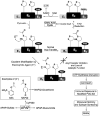Electrophile-modified lipoic derivatives of PDC-E2 elicits anti-mitochondrial antibody reactivity
- PMID: 21763105
- PMCID: PMC3206141
- DOI: 10.1016/j.jaut.2011.06.001
Electrophile-modified lipoic derivatives of PDC-E2 elicits anti-mitochondrial antibody reactivity
Abstract
Our laboratory has hypothesized that xenobiotic modification of the native lipoyl moiety of the major mitochondrial autoantigen, the E2 subunit of the pyruvate dehydrogenase complex (PDC-E2), may lead to loss of self-tolerance in primary biliary cirrhosis (PBC). This thesis is based on the finding of readily detectable levels of immunoreactivity of PBC sera against extensive panels of protein microarrays containing mimics of the inner lipoyl domain of PDC-E2 and subsequent quantitative structure-activity relationships (QSARs). Importantly, we have demonstrated that murine immunization with one such mimic, 2-octynoic acid coupled to bovine serum albumin (BSA), induces anti-mitochondrial antibodies (AMAs) and cholangitis. Based upon these data, we have focused on covalent modifications of the lipoic acid disulfide ring and subsequent analysis of such xenobiotics coupled to a 15mer of PDC-E2 for immunoreactivity against a broad panel of sera from patients with PBC and controls. Our results demonstrate that AMA-positive PBC sera demonstrate marked reactivity against 6,8-bis(acetylthio)octanoic acid, implying that chemical modification of the lipoyl ring, i.e. disruption of the S-S disulfide, renders lipoic acid to its reduced form that will promote xenobiotic modification. This observation is particularly significant in light of the function of the lipoyl moiety in electron transport of which the catalytic disulfide constantly opens and closes and, thus, raises the intriguing thesis that common electrophilic agents, i.e. acetaminophen or non-steroidal anti-inflammatory drugs (NSAIDs), may lead to xenobiotic modification in genetically susceptible individuals that results in the generation of AMAs and ultimately clinical PBC.
Copyright © 2011 Elsevier Ltd. All rights reserved.
Figures





Similar articles
-
Xenobiotics and loss of tolerance in primary biliary cholangitis.World J Gastroenterol. 2016 Jan 7;22(1):338-48. doi: 10.3748/wjg.v22.i1.338. World J Gastroenterol. 2016. PMID: 26755880 Free PMC article. Review.
-
Antimitochondrial antibody heterogeneity and the xenobiotic etiology of primary biliary cirrhosis.Hepatology. 2013 Apr;57(4):1498-508. doi: 10.1002/hep.26157. Epub 2013 Jan 29. Hepatology. 2013. PMID: 23184636 Free PMC article.
-
Environment and primary biliary cirrhosis: electrophilic drugs and the induction of AMA.J Autoimmun. 2013 Mar;41:79-86. doi: 10.1016/j.jaut.2012.12.007. Epub 2013 Jan 24. J Autoimmun. 2013. PMID: 23352659 Free PMC article.
-
Chemical xenobiotics and mitochondrial autoantigens in primary biliary cirrhosis: identification of antibodies against a common environmental, cosmetic, and food additive, 2-octynoic acid.J Immunol. 2005 May 1;174(9):5874-83. doi: 10.4049/jimmunol.174.9.5874. J Immunol. 2005. PMID: 15845458
-
A contemporary perspective on the molecular characteristics of mitochondrial autoantigens and diagnosis in primary biliary cholangitis.Expert Rev Mol Diagn. 2016 Jun;16(6):697-705. doi: 10.1586/14737159.2016.1164038. Epub 2016 Mar 30. Expert Rev Mol Diagn. 2016. PMID: 26953925 Free PMC article. Review.
Cited by
-
New insights into the pathogenesis of primary biliary cholangitis asymptomatic stage.World J Gastroenterol. 2023 Oct 7;29(37):5292-5304. doi: 10.3748/wjg.v29.i37.5292. World J Gastroenterol. 2023. PMID: 37899787 Free PMC article. Review.
-
Xenobiotics and loss of tolerance in primary biliary cholangitis.World J Gastroenterol. 2016 Jan 7;22(1):338-48. doi: 10.3748/wjg.v22.i1.338. World J Gastroenterol. 2016. PMID: 26755880 Free PMC article. Review.
-
Human intrahepatic biliary epithelial cells engulf blebs from their apoptotic peers.Clin Exp Immunol. 2013 Apr;172(1):95-103. doi: 10.1111/cei.12046. Clin Exp Immunol. 2013. PMID: 23480189 Free PMC article.
-
Autoimmunity in 2011.Clin Rev Allergy Immunol. 2012 Aug;43(1-2):194-206. doi: 10.1007/s12016-012-8330-2. Clin Rev Allergy Immunol. 2012. PMID: 22733376 Review.
-
Anti-kelch-like 12 and anti-hexokinase 1: novel autoantibodies in primary biliary cirrhosis.Liver Int. 2015 Feb;35(2):642-51. doi: 10.1111/liv.12690. Epub 2014 Oct 10. Liver Int. 2015. PMID: 25243383 Free PMC article. Clinical Trial.
References
-
- Invernizzi P. Geoepidemiology of autoimmune liver diseases. J Autoimmun. 2010;34:J300–6. - PubMed
-
- Gershwin ME, Mackay IR. The causes of primary biliary cirrhosis: Convenient and inconvenient truths. Hepatology. 2008;47:737–45. - PubMed
-
- Agmon-Levin N, Shapira Y, Selmi C, Barzilai O, Ram M, Szyper-Kravitz M, et al. A comprehensive evaluation of serum autoantibodies in primary biliary cirrhosis. J Autoimmun. 2010;34:55–8. - PubMed
-
- Tiegs G, Lohse AW. Immune tolerance: what is unique about the liver. J Autoimmun. 2010;34:1–6. - PubMed
Publication types
MeSH terms
Substances
Grants and funding
LinkOut - more resources
Full Text Sources
Miscellaneous

